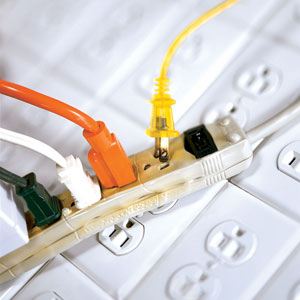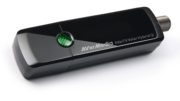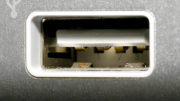Chances are you have one room in your house where a lot of technology lives. Maybe that’s where your router is, perhaps it’s where you charge your phone. In that room you probably have at least one power strip. If you’re like many of us, there are multiple extension cords plugged into that one strip. So how far can you go with this idea? What’s the total amount of stuff you can plug into one outlet?
You’re not going to like the answer.
If that room is a home office, you might have a lot of things plugged in at the same time. In addition to a computer, printer, router, monitor, desk lamp and cable modem, you may have a TV, cable box, various chargers for cell phones, and even a fax machine if you’re truly old-school. This room might be where you spent most of the pandemic. That gave you time to wonder… are those outlets working overtime? Should you be worried?
Probably.
Here’s the strictly correct answer. The total draw on all the outlets in a circuit can’t exceed the rating on the circuit breaker. If it does, the circuit will trip. And I’m not talking about a single outlet here. Chances are you have one breaker for all the bedrooms. That makes things even more worrisome.
All those devices can be drawing a lot of power. How much? Look at all the power supplies. Most “wall warts” will have an amperage rating, usually listed in milliamps (mA.) The average wall circuit is 20 amps, or 20,000mA. Add up all the listed amperages. You might not know what the circuit breaker is rated for. You can look in the breaker box and see the number on it. In most cases it’s 16-20 amps. If you’re pulling more than that, or even if you’re pulling close to that, you’ve got trouble.
Here’s what to do.
First, feel around to all of those plugs. Are any of them hot? Are any of the extension cords hot? This could be a sign of danger. Unplug anything that’s hot right away and look to see if there are frayed cords or anything like that. Those should be replaced without any further ado.
Next, simplify. How many things are plugged in that you don’t use every day? What about that radio you don’t listen to, or the GPS you haven’t touched since you got an iPhone? Unplug them.
Take chargers that you don’t use all the time and put them on a switched power strip. Keep it turned off except when you are charging the actual devices; this will save you power and money as well.
If that doesn’t do it, hire an electrician (or if you are handy, do it yourself) to run a second circuit into your home office. It’s worth it. Circuit breakers are supposed to handle an overload, but you certainly don’t want to have to put them to the test.
Be smart… shop at Solid Signal
An even better option awaits. Take a look at those older obsolete devices you still have plugged in. Maybe it’s time to recycle them responsibly and get new ones. You can get a lot of what you’re looking for when you shop at Solid Signal. If you need some help choosing the right thing, call us at 888-233-7563. We’re here during East Coast business hours with technicians at the ready. If it’s after hours, fill in the form below. We’ll get back to you, usually within one business day.





